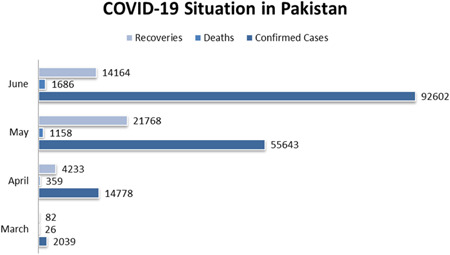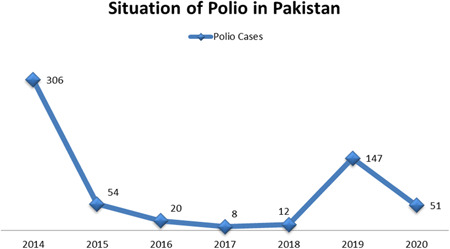To the Editor,
A recent report reviewed the Poliomyelitis (polio) epidemiology in Pakistan. 1 Pakistan is currently showing a very high number of COVID‐19 cases. 2 The outbreak of COVID‐19 has been known to cause by SARS‐CoV‐2, a novel coronavirus that emerged by the end of December 2019. By 19th June 2020, COVID‐19 has claimed the lives of 450 686 people and has been reported to infect almost 8 385 440 people worldwide. 3 Pakistan has reported 4944 cases in a single day, taking the toll of total infected cases to 165 062, and 3229 people have lost the battle of life against COVID‐19 4 (Figure 1). Another health emergency; Polio is looming as the country is battling against the COVID‐19 pandemic. Poliomyelitis is an infectious disease caused by Poliovirus that is a serotype of the specie Enterovirus C belonging to the family Picornaviridae. Poliovirus is a single‐stranded RNA virus of about 7500 nucleotides long enclosed in an icosahedral protein capsid of 30 nm in diameter. Horizontal transmission of the virus is mainly through the fecal‐oral route. 5 , 6 To date there are three strains of poliovirus, based on their slight differences in the capsid protein coat; PV‐1, PV,2, and PV‐3. Since 1988, there has been a 99% reduction in the global occurrence rate of polio infected cases; declining from 350 000 cases to only 175 reported cases in the year 2019. Wild PV‐2 and PV‐3 have been declared eradicated since last been detected in 1999 and 2012, respectively. However, as of March 2020, wild poliovirus serotype 1 (PV‐1) is still concentrated in Pakistan and Afghanistan. 7
Figure 1.

Number of COVID‐19 confirmed cases in Pakistan (From 1st March 2020 to 19th June 2020). *Data collected from National Institute of Health, Pakistan (NIH) 4
Wild type poliovirus has been eradicated by the world as a result of mass vaccination launched by the Global Polio Eradication Initiative (GPEI) in 1988 except three countries; Afghanistan, Pakistan, and Nigeria. Pakistan is still struggling against the poliovirus eradication. Since 2015, the Pakistan polio program has performed admirably well bringing 306 cases in 2014 to only 54 cases in 2015, 20 in 2016, declining to an all‐time low of eight reported cases in 2017, 12 in 2018 and then surging up to 147 cases in 2019 8 , 9 (Figure 2). As of June 2020, 51 cases have been reported so far, the environmental samples collected from around the country suggested that 65% of them were positive for poliovirus being highest in Sindh and Balochistan. 10 On 4th June 2020, the deputy commissioner (DC) of Multan issued polio alerts after detecting poliovirus in sewerage water. 11 By 18th June 2020, one polio case has been reported in both Chaman and Upper Dir District of Khyber Pakhtunkhuwa. 12 , 13 Due to the COVID‐19 outbreak, 40 million children in Pakistan have missed the polio vaccination since April when all vaccination programs were suspended.
Figure 2.

Number of confirmed polio cases in Pakistan (From the year 2014 to 19th June 2020). *Data collected from Pakistan Polio Eradication Programme 9
Many challenges lie in the way of making Pakistan a polio‐free region; a major hurdle is the high number of children missed during vaccination campaigns, refusal from parents, illiteracy, poverty, misconceptions related to its halal nature, and administration of expired polio vaccine. 14 In addition to these challenges, Pakistan was struggling hard to eradicate polio but since late March 2020, a standstill in routine immunizations has been observed amid the COVID‐19 outbreak. The lockdown of schools, public gatherings, public transport, public, and private hospitals restricted out‐patient departments have halted the vaccinations. The government of Pakistan has also diverted all its staff and resources to fight against the COVID‐19. 15
COVID‐19 infection has a very serious impact on world economy and due to these economic crises, world will face several health issues especially in developing and underdeveloped countries. 16 , 17 Coepidemics of other infections/diseases will make the conditions worse. 18 , 19 Due to the very infectious nature of COVID‐19, the World Health Organization (WHO) and Global Vaccine advocates have suggested postponing the mass vaccine campaigns as they include door‐to‐door polio programs that would risk the polio workers, children who receive polio vaccines, and their families to get infected with COVID‐19. As of 26th March, WHO stated to postpone mass immunization during COVID‐19 Pandemic. 20
The long term trajectory of the pandemic is uncertain, which would affect the marginalized poor countries that are struggling on other fronts like; economic stability, dengue, tuberculosis, measles, and, polio. Halting the immunization program might help in containing the COVID‐19 transmission but it would also escalate the risk of attaining other infectious diseases that can be prevented by vaccination. Discontinuing the polio vaccination program may not have an immediate effect but in the long term, the increase in the incidence of polio cases in Pakistan can also result in the worldwide export of infections. Thus, it would be a wise decision to continue the immunization program while keeping account of social distancing measures and all the SOP's to flatten the COVID‐19 transmission curve.
CONFLICT OF INTERESTS
The authors declare that there are no conflict of interests.
AUTHOR CONTRIBUTIONS
All authors conceived the study, discussed the results, drafted the first manuscript, critically read and revised the manuscript, and gave final approval for publication.
REFERENCES
- 1. Shabbir RMK, Saleem S, Khan A, Afzal MS, Qureshi UM, Ahmed H. Hot spots, risk factors and management of polio virus in Pakistan. J Med Virol. 2020. 10.1002/jmv.26058 [DOI] [PubMed] [Google Scholar]
- 2. Haqqi A, Awan UA, Ali M, Man S, Ahmed H, Afzal MS. COVID‐19 and dengue virus co‐epidemics in Pakistan: a dangerous combination for overburdened healthcare system. J Med Virol. 2020. 10.1002/jmv.26144 [DOI] [PMC free article] [PubMed] [Google Scholar]
- 3.Organization WH. Coronavirus disease (COVID‐19) Situation Report – 151. https://www.who.int/docs/default-source/coronaviruse/situation-reports/20200619-covid-19-sitrep-151.pdf?sfvrsn=8b23b56e_2. Accessed June 19, 2020.
- 4. Health NI COVID‐19 Dashboard. http://covid.gov.pk/stats/pakistan. Accessed June 19, 2020.
- 5. Ryan KJ, Ray CG. Medical microbiology. McGraw Hill. 2004;4:370. [Google Scholar]
- 6. Hogle JM. Poliovirus cell entry: common structural themes in viral cell entry pathways. Annual Reviews in Microbiology. 2002;56(1):677‐702. [DOI] [PMC free article] [PubMed] [Google Scholar]
- 7. Hussain SF, Boyle P, Patel P, Sullivan R. Eradicating polio in Pakistan: an analysis of the challenges and solutions to this security and health issue. Global Health. 2016;12(1):63. [DOI] [PMC free article] [PubMed] [Google Scholar]
- 8. Organization WH Pakistan‐Polio Eradication Initiative. http://www.emro.who.int/pak/programmes/polio-eradication-initiative.html. Accessed June 5, 2020.
- 9. Programme PPE WPV Polio Cases Across Pakistan's Provinces. Accessed June 19, 2020. https://www.endpolio.com.pk/polioin-pakistan/polio-cases-in-provinces
- 10. Programme PPE Pakistan Polio Update ‐ June 2020. http://polioeradication.org/where-we-work/pakistan/#:~:text=Polio%20this%20week%20in%20Pakistan&text=The%20number%20of%20cases%20reported,Punjab%20and%2014%20in%20Sindh. Accessed June 19, 2020.
- 11. News IT Polio alert issued after polio virus detected in sewerage water. https://www.thenews.com.pk/print/667787-polio-alert-issued-after-polio-virus-detected-in-sewerage-water. Accessed June 5, 2020.
- 12. Today P Chaman reports polio case. Updated 05‐06‐2020. Accessed June 19, 2020. https://www.pakistantoday.com.pk/2020/06/05/chaman-reports-polio-case/
- 13. Web R CrisisInSight Weekly Picks‐Pakistan, 18 June 2020. Updated 18‐06‐2020. https://reliefweb.int/report/central-african-republic/crisisinsight-weekly-picks-18-june-2020. Accessed June 19, 2020.
- 14. Waheed Y. Polio eradication challenges in Pakistan. Clin Microbiol Infect. 2018;24(1):6‐7. [DOI] [PubMed] [Google Scholar]
- 15.National Action Plan for Corona Virus Disease (COVID‐19) Pakistan. Updated 13‐March‐2020. https://www.nih.org.pk/wp-content/uploads/2020/03/COVID-19-NAP-V2-13-March-2020.pdf
- 16. Kabir M, Afzal MS, Khan A, Ahmed H. COVID‐19 economic cost; impact on forcibly displaced people. Travel Med Infect Dis. 2020;35:101661. [DOI] [PMC free article] [PubMed] [Google Scholar]
- 17. Kabir M, Saqib MAN, Zaid M. COVID‐19 economic impact and child mortality: a global concern. Clin Nutr. 2020;39(7):2322–2323. 10.1016/j.clnu.2020.05.027 [DOI] [PMC free article] [PubMed] [Google Scholar]
- 18. Li ZT, Chen ZM, Chen LD, et al. Coinfection with SARS‐CoV‐2 and other respiratory pathogens in COVID‐19 patients in Guangzhou, China. J Med Virol. 2020. 10.1002/jmv.26073 [DOI] [PMC free article] [PubMed] [Google Scholar]
- 19. Ribeiro VST, Telles JP, Tuon FF. Arboviral diseases and COVID‐19 in Brazil: concerns regarding climatic, sanitation, and endemic scenario. J Med Virol. 2020. 10.1002/jmv.26079 [DOI] [PMC free article] [PubMed] [Google Scholar]
- 20. Organization WH Protecting lifesaving immunization services during COVID‐19: New guidance from WHO. https://www.who.int/immunization/news_guidance_immunization_services_during_COVID-19/en/. Accessed June 5, 2020.


